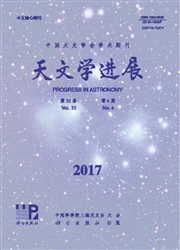

 中文摘要:
中文摘要:
探测系外行星的最终目的是为了寻找系外生命和宜居行星,而系外行星大气是人们了解行星宜居特性的窗口,所以系外行星大气的研究至关重要。近10年来,系外行星大气的理论研究和观测都发展迅速。受观测技术限制,目前观测到大气的系外行星主要是用凌星法探测到的热木星和超级地球,还有用直接成像法探测到的离主星较远的年轻气态巨行星。力求在系外行星大气领域飞速发展之际,对该领域研究现状做简明介绍。首先介绍系外行星大气的观测方法,随后介绍热木星和超级地球的大气概况和研究现状,最后对系外行星大气探测的有关项目进行简要介绍,以展示未来系外行星大气研究的前景。
 英文摘要:
英文摘要:
The ultimate goal for detecting exoplanets is to search for extraterrestrial life and habitable terrestrial planets. The exoplanetary atmosphere acts as a good window to understand exoplanet's characteristics and habitability. Hence, such investigation is one of the most significant frontiers in astronomy. In the last decade, tremendous achievements have been made on the theories of the exoplanetary atmosphere, and observations through photometric and spectroscopic methods using a variety of space-borne and ground-based observational facilities. However, currently the atmosphere observations mainly come from transiting hot Jupiters, super-Earths and direct imaging giant planets, because of limitation in current observational techniques. The present review attempts to succinctly summarize current investigations in this field. First, we briefly describe the methods of observing exoplanetary atmospheres. Next, we review the fundamental facts, nowadays research progress of atmospheres for hot Jupiters and super-Earths. Finally, we present an introduction of the projects, which are involved in exoplanetary atmosphere detection to show the bright prospects for future investigation.
 同期刊论文项目
同期刊论文项目
 同项目期刊论文
同项目期刊论文
 期刊信息
期刊信息
